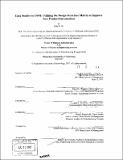Case studies in DSM : utilizing the Design Structure Matrix to improve New Product Introduction
Author(s)
Go, Julie W
DownloadFull printable version (7.136Mb)
Alternative title
Utilizing the design structure matrix to improve New Product Introduction
Other Contributors
Leaders for Manufacturing Program.
Advisor
Daniel E. Whitney and Sara L. Beckman.
Terms of use
Metadata
Show full item recordAbstract
This thesis describes a project that applies the Design Structure Matrix (DSM) in support of the Manufacturing Excellence (MX) program at Cisco Systems, Inc to reduce the cycle time of new product development initiatives (NPI). Because they are inherently iterative with interdependent tasks, NPIs are difficult to manage. Two case studies applying the DSM were performed and used to study the inputs and outputs of the process as well as the dependencies between the process steps. Both case studies indicated that defining product requirements and needs upfront helped to eliminate rework later on in the process. The DSMs also showed that cycle time and standard deviation of cycle time were especially sensitive to interactions between changes in the Bill of Materials (BOM) and other tasks. In fact there was a "tipping point" where reducing the dependency between tasks could yield significant reductions in cycle time and standard deviation of cycle time. More significantly, the case studies highlighted the large number of stakeholders involved in the process and revealed the degree to which engineering and manufacturing must work together to reduce NPI cycle times. (cont.) In fact, the name "Manufacturing Excellence Initiative in NPI" is a misnomer. New Product Introduction is not just the job of manufacturing but is highly integrated between such groups as marketing, design, and engineering. If the Mx Initiative in NPI is to fully meet its potential, all of these groups must fully realize this. In addition, there is a need for process infrastructure, data infrastructure, and close examination of incentives. This thesis thus shows that in order for Cisco's process improvement initiatives to succeed, buy-in from all relevant stakeholders must be won.
Description
Thesis (M.B.A.)--Massachusetts Institute of Technology, Sloan School of Management; and, (S.M.)--Massachusetts Institute of Technology, Engineering Systems Division; in conjunction with the Leaders for Manufacturing Program at MIT, 2007. Includes bibliographical references (p. 63).
Date issued
2007Department
Leaders for Manufacturing Program at MIT; Massachusetts Institute of Technology. Engineering Systems Division; Sloan School of ManagementPublisher
Massachusetts Institute of Technology
Keywords
Sloan School of Management., Engineering Systems Division., Leaders for Manufacturing Program.